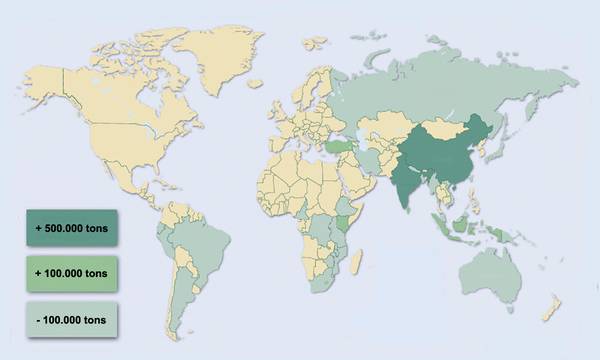 |
CHINA
Tea cultivation since: 221 v. Chr. tea was used for medical purposes and a tea tax existed. Since 618 tea was drunken as stimulant.
Production: Ca. 1.200.000 t
Export: Ca. 290.000 t
Regions:
Anhui, Fujian, Guangdong, Guizhou, Hunan, Hubei, Jiangsu, Jiangxi, Sichuan, Shaanxi, Yunnan and Zhejiang
Production:
Black and green tea, orthodox and CTC tea, white tea, Oolong, Pu Erh tea, aromatized and compressed teas.

|
 |
INDIA
Tea cultivation since: 1823
Production: Ca. 950.000 t
Export: Ca. 154.000 t
Regions:
Assam, Darjeeling, Terai, Dooars and Ceylon-similar teas. Flown-in tea, 1st flush, 2nd flush, intermediate harvest, autumn harvest
Production:
Black and green tea, orthodox and CTC tea
Packaging:
Paper sacks, chests, cartons, big bags, individual packaging of 1-10 kg, semi-hand packed |
 |
KENYA
Tea cultivation since: 1823
Production: Ca. 370.000 t
Export: Ca. 344.000 t
Regions:
Tea production at the foot of Mount Kenya, on the shores of Lake Victoria and on the slopes of the Rift Tales. Approx. 99% of Kenyan tea is CTC production. The main features of this tea are the even black leaves and a rich, strong fresh cup.
Production:
Black tea CTC and small amounts of orthodox tea |
 |
SRI LANKA
Tea cultivation since: 1860
Production: Ca. 305.000 t
Export: Ca. 294.000 t
Regions:
“Champagne” types of the highland regions: Nuwara Eliya, Dimbula and Uva regions. Teas with dark cup in the lower production regions.
Production:
Black tea, orthodox tea, orthodox, Rotovane and CTC tea, small amounts of green tea |
 |
TURKEY
Tea cultivation since: Ende des 19. Jh.
Production: Ca. 180.000 t
Export: Ca. 3.000 t
Regions:
The cultivation regions are located along the border to Georgia and along the Black Sea coast of Turkey. The teas, which are relatively light, are mainly produced for domestic consumption.
Production:
Orthodox tea, orthodox |
 |
INDONESIA
Tea cultivation since: Java: 1728, Sumatra: 1911
Production: Ca. 150.000 t
Export: Ca. 84.000 t
Regions:
Java/Sumatra offer good to average teas. The quality varies during the year.
Production:
Black and green tea, orthodox and CTC tea |
 |
VIETNAM
Tea cultivation since: 1955
Production: Ca. 148.000 t
Export: Ca. 111.000 t
Production: Black and green tea
Regions:
The producing areas in Vietnam have grown almost three times in size since the 80s. The black and green teas produced are similar to certain Chinese teas and provide a good alternative. The tea plantations are mainly located in the mounainous regions of the north and northern central Vietnam. |
 |
JAPAN
Tea cultivation since: 709
Production: Ca. 100.000 t
Export: Ca. 1.800 t
Regions:
Production mainly on the islands of Honshu and Kyushu. The region with most production is Shizouka at the foot of the Fujiama Mountains, where almost half of all Japanese tea is grown.
Production:
Green Tea |
 |
ARGENTINA
Tea cultivation since: 1951
Production: Ca. 90.000 t
Export: Ca. 74.240 t
Regions:
Tea is produced mainly in the Missiones Province on the border to Brazil. These teas are mainly used for blends.
Production:
Orthodox black tea (Fannings), Yerba Mate |
 |
BANGLADESH
Tea cultivation since: 1947
Production: Ca. 58.000 t
Regions:
Tea production mainly in the north-Eastern district of Sylhet and in the area of the City of Chittagong in the south-east. About 90% of the production is absorbed by the internal market.
Production:
Black tea, orthodox and CTC |
 |
MALAWI
Tea cultivation since: 1905
Production: Ca. 48.000 t
Export: Ca. 47.000 t
Regions:
Malawi was the first country in which tea was produced for commercial use. The plants came from the Botanical Garden in Edinburgh. The plantations are located in the South of the country as well as in the North, by Lake Nyasa.
Production:
Black tea CTC |
 |
UGANDA
Tea cultivation since: 1909
Production: Ca. 45.000 t
Export: Ca. 44.000 t
Regions:
Commercial tea production started in the 30s. In the 70s the teas were comparable with the Kenyan teas. The quality and amounts were reduced later due to political instability: This negative tendency continues even today.
Production:
Black tea CTC |
 |
TANZANIA
Tea cultivation since: 1905
Production: Ca. 35.000 t
Export: Ca. 29.120 t
Regions:
Tea production in the Usambara Mountains and in the southern highlands.
Production:
Black tea CTC and small amounts of orthodox tea |
 |
IRAN
Tea cultivation since: 1898
Production: Ca. 18.000 t
Export: Ca. 5.000 t
Regions:
Production mainly for national needs. The production areas are located on the south banks of the Caspian Sea and on the slopes of the Alborz mountain range.
Production:
Black tea, orthodox tea, small amounts of CTC tea |
 |
RWANDA
Tea cultivation since: 1950ies
Production: Ca. 17.000 t
Export: Ca. 13.000 t
Regions:
The climatic conditions are similar to those in Uganda. Production: Black tea, orthodox and CTC |
 |
NEPAL
Tea cultivation since:
۱۸۴۰ first cultivation attemps took place. Commercial cultivation first began in 1985 in the east of Nepal
Production: Ca. 14.000 t
Export: Ca. 7.000 t
Regions:
East of Nepal, directly next to Darjeeling. Nepal teas are similar to Darjeeling teas.
Production:
Black tea, orthodox and CTC, small quantities of green tea |
 |
ZIMBABWE
Tea cultivation since: 1920
Production: Ca. 13.000 t
Export: Ca. 7.600 t
Regions:
Tea production at the border to Mozambique in the regions of Chipinga and Inyanga.
Production:
Black tea CTC |
 |
SOUTH AFRICA
Tea cultivation since: 1877
Production: Ca. 10.000 t
Export: Ca. 575 t
Regions:
Tea production in Kwazulu, West Transvaal, Natal, Zululand and Transkei. Almost 100% of the black tea produced is consumed in the country.
Production:
Black tea CTC, Rooibos, Honeybush |
 |
PAPUA NEUGUINEA
Tea cultivation since: 1964
Production: Ca. 7.000 t
Export: Ca. 5.800 t
Regions:
Cultivation in the western highlands. The teas are neutral and slightly astringent.
Production: Black tea CTC |
 |
GEORGIA
Tea cultivation since: 1847
Production: Ca. 4.200 t
Export: Ca. 900 t
Regions:
Cultivation on the eastern black sea coast. These plantations mainly consist of Chinese varieties. For this reason the Georgian teas have a realtively low amount of tannic acid and a correspondingly light cup.
Production:
Black tea orthodox |
 |
CAMEROON
Tea cultivation since: 1914
Export: Ca. 4.300 t
Regions:
These teas have a harmonic aroma and are relatively low in amounts of tannin.
Production:
Black tea CTC |
 |
MOZAMBIQUE
Tea cultivation since: 1920
Production: Ca. 3.400 t
Export: Ca. 1.100 t
Production:
Black tea CTC |
 |
Rest of the world
Smaller amounts of tea are produced in the following countries: Australia, Ecuador, Brazil, Peru. |








